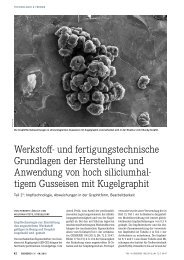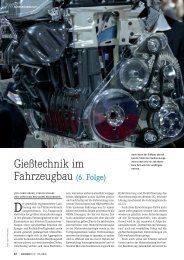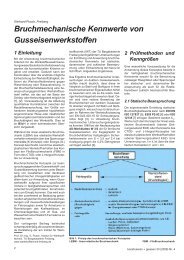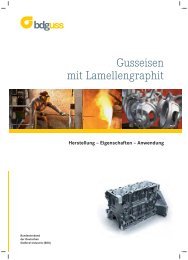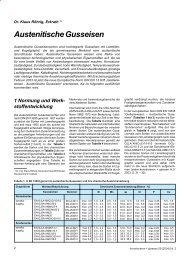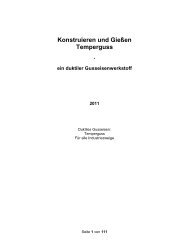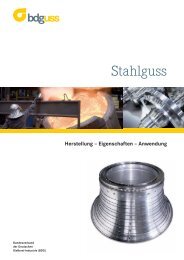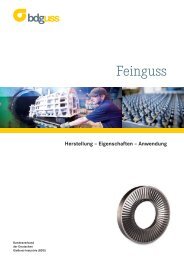Giesserei Literaturschau - Bundesverband der Deutschen Gießerei ...
Giesserei Literaturschau - Bundesverband der Deutschen Gießerei ...
Giesserei Literaturschau - Bundesverband der Deutschen Gießerei ...
Erfolgreiche ePaper selbst erstellen
Machen Sie aus Ihren PDF Publikationen ein blätterbares Flipbook mit unserer einzigartigen Google optimierten e-Paper Software.
BDG Informationszentrum<br />
Eisengusswerkstoffe<br />
Dokumenten-Nummer: 57824<br />
Tagungsbeitrag<br />
Heckmann, C. J.; Stets, W.; Wolf, G.<br />
Publikationssprache: Englisch<br />
Plate Fracture of Nodular Cast Iron<br />
Plattenbruch bei Gusseisen mit Kugelgraphit<br />
Plate fracture is a defective fracture structure in nodular cast iron that can be found especially in the transition area of<br />
fee<strong>der</strong>, fee<strong>der</strong> neck and the cast part itself. It occurs rather spontaneously due to the fact that the exact reason for it is<br />
still unknown. The microstructure of the casting in the area of plate fracture comprises aligned graphite nodules in<br />
combination with a pronounced dendritic microstructure as characteristical features. A series of casting trials was<br />
performed in which plate like samples were produced. It could be shown by means of metallographic investigation of<br />
these samples in combination with the simulation of the solidification that specific local conditions during the<br />
solidification are the metallurgical reasons for the appearance of plate fracture. These specific conditions were the local<br />
temperature gradient and the velocity of the liquid/solid interface.<br />
Institut für Gießereitechnik (IfG), Düsseldorf, DE<br />
Erscheinungsjahr 2010<br />
S. S.367-373<br />
Seiten/Bil<strong>der</strong>/Tabellen/Quellen: 7S<br />
Eisengusswerkstoffe<br />
Dokumenten-Nummer: 57844<br />
Tagungsbeitrag<br />
Hirose, Masanori; Yamamoto, Kaoru; Miyahara, Hirofumi; Sakata, Kazunori; Ogi, Keisaku<br />
Publikationssprache: Englisch<br />
Abrasion Behavior of High Cr-V-Nb Cast Iron<br />
Verhalten bei Abrasivverschleiß von hochlegiertem Cr-V-Nb-Gusseisen<br />
A series of abrasion tests on high Cr-V-Nb cast irons revealed that the addition of MC type carbide formers, V and Nb,<br />
remarkably enhances the abrasion resistance of high Cr cast iron, and the abrasion resistance becomes higher with the<br />
increase in MC type carbides[1]. Therefore, hyper eutectic Fe-4.7%C-15%Cr-7%V-5%Nb-5%Mo alloy melt was poured into<br />
30 kg and 1 kg sand mold castings to distribute different sizes of primary and eutectic carbides in hardenable matrix.<br />
The abrasion test specimens cut from each casting were austenitized at 1323 K for 1h then cooled in air. These<br />
specimens were tempered at 773 K for 1h followed by air cooling. The hardness of specimens was 1015-1018HV50.<br />
The rubber wheel abrasion test, a typical 3 body type one, was performed on these quenched and tempered specimens<br />
with 56-107, 107-150 and 297 micro m dia. silica grit. The testing load was 86.3 N and 172.5 N, and the rubber wheel<br />
rotation speed was varied from 1 s(exp -1) to 4 s(exp -1). Though the higher testing load increases the wear loss, the<br />
wear rate expressed by the wear volume/(testing load x wear distance) changes depending on the wear condition and<br />
the microstructure. In case of 30 kg cast specimen, the silica grit preferentially attack and scrape off the matrix, and<br />
the wear rate increases with the increase in the testing load. The fine carbides in 1 kg cast specimens effectively<br />
protect the matrix from the attack of silica grit, and the wear rate decreases with increasing load which causes silica<br />
grit blunt and fracture. However, fine carbides tend to be fractured by silica grit and diminish the protective effect.<br />
Based on the worn surface structures, the abrasion mechanism is discussed comparing those of steel and eutectic<br />
25%Cr cast iron.<br />
Fukuoka Industrial Technology Center, Kitakyushu, JP; Kurume National College of Technology, JP; Kyushu University,<br />
Fukuoka, JP; Fujikikosan, Kitakyushu, JP; Oita National College of Technology, JP<br />
Erscheinungsjahr 2010<br />
S. S.243-248<br />
Seiten/Bil<strong>der</strong>/Tabellen/Quellen: 6S<br />
<strong>Giesserei</strong> <strong>Literaturschau</strong>



